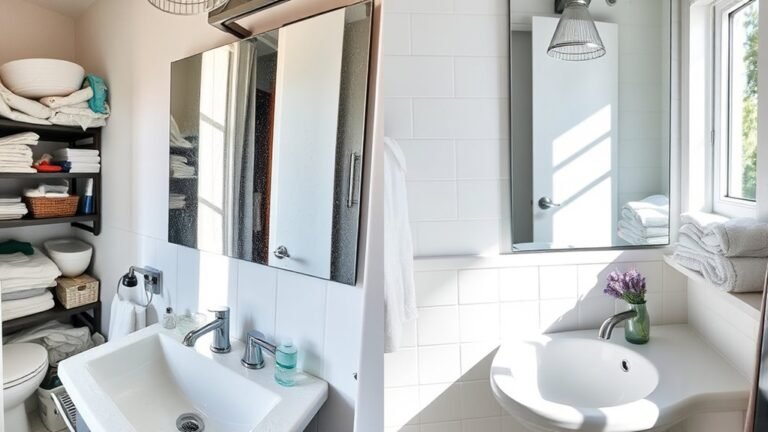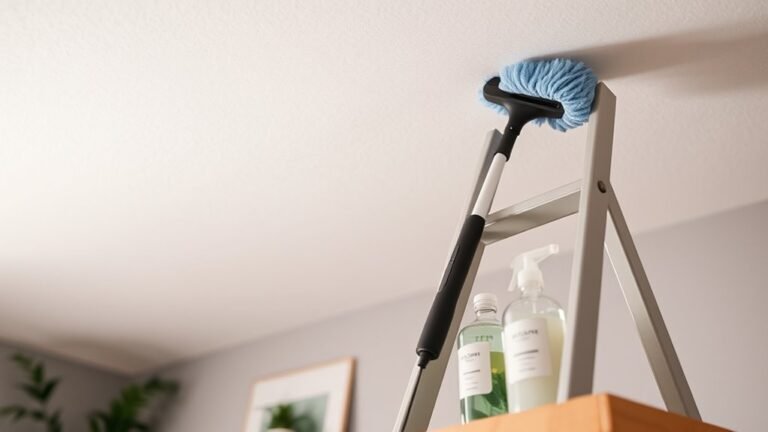Cleaning and Organizing Your Linen Closet
Start by evaluating your linens, setting aside worn or unused items to donate. Empty the closet and wipe shelves clean, checking for mildew or pests. Next, sort everything by category and size—bath towels, sheets, pillowcases—to keep things neat. Use storage solutions like shelf dividers, vacuum bags, or baskets to save space and keep items accessible. Finally, maintain your setup with regular upkeep. If you want to create a truly streamlined and fresh linen closet, there’s more to discover.
Assess and Declutter Your Linens

Before you plunge into organizing, take a moment to evaluate and declutter your linens. Sorting through different linen types—sheets, towels, blankets—helps you see what you truly need. Ask yourself which items you use regularly and which sit forgotten. This clarity frees up space and reduces overwhelm. Anything stained, worn, or unused? Set those aside. Instead of tossing them, explore donation options; many shelters and charities welcome gently used linens. This way, your decluttering benefits others while lightening your load. By thoughtfully evaluating your linens, you’re not just tidying up—you’re creating a sense of freedom and ease in your home. Embrace this step as a foundation for a clutter-free, liberating linen closet.
Clean and Prepare the Closet Space
Once you’ve sorted through your linens, it’s time to turn your attention to the closet itself. Start by removing everything to free up the shelf space completely. This gives you a blank canvas to work with and makes closet cleaning more effective. Use a gentle cleaner and a damp cloth to wipe down shelves, walls, and corners, removing dust and any lingering odors. Don’t forget to check for mildew or pests that could damage your linens. Let the closet air out for a bit to guarantee it’s fresh and dry before you return anything. Taking these steps not only protects your linens but also creates a calm, inviting space where everything has its place. You’re setting yourself up for a truly organized and liberating linen closet experience.
Sort Linens by Category and Size

Sorting your linens into clear categories and sizes makes finding what you need quick and hassle-free. By grouping linen types—like towels, sheets, and pillowcases—you create a system that saves time and keeps your closet orderly. Consider the variety of storage options within your closet when sorting; matching sizes together guarantees everything fits neatly.
| Linen Type | Size | Quantity |
|---|---|---|
| Bath Towels | Large | 8 |
| Hand Towels | Medium | 12 |
| Bed Sheets | Twin/Full | 6 sets |
| Pillowcases | Standard/King | 10 |
| Washcloths | Small | 15 |
This approach lets you enjoy freedom in your space, reducing stress and keeping your linens accessible.
Choose Storage Solutions and Organizers
Choosing the right storage solutions can transform your linen closet from cluttered to custom-tailored. Start by adding shelf dividers to separate towels, sheets, and blankets, giving each category its own neat space. These dividers help you avoid piles tumbling over and make grabbing what you need quicker. Vacuum bags are a game-changer for bulky items like comforters or seasonal bedding—they compress bulky fabrics, freeing up valuable space. Opt for clear vacuum bags so you can see what’s inside without opening them. Baskets or bins also keep smaller items organized and easy to find. By selecting the right organizers, you’ll create a linen closet that feels spacious and liberating, making it easier to maintain order and enjoy your newfound freedom from clutter.
Maintain an Organized Linen Closet Regularly

Keeping your linen closet organized takes just a few minutes each week, but it makes a big difference over time. By developing simple closet organization habits, you’ll prevent clutter from piling up and keep your linens fresh and accessible. Start by quickly folding or straightening towels and sheets after use, and return items to their designated spots. Regularly check for any worn or outdated linens to donate or recycle, freeing up space. Incorporate linen maintenance tips like airing out your closet to avoid musty smells and using breathable storage containers. These small, consistent actions give you the freedom to find what you need effortlessly, making your linen closet a stress-free zone rather than a chaotic mess. Stick to these habits, and your organized closet will stay that way with minimal effort.
Frequently Asked Questions
How Often Should I Wash My Stored Linens?
It’s funny how linens, tucked away, seem untouched yet quietly collect dust and odors. For proper linen care, you should wash stored linens every three to six months to maintain freshness and hygiene. Your washing frequency depends on usage and storage conditions, but regular rotation and airing out also help. Keeping this routine lets you enjoy freedom from musty smells and guarantees your linens feel inviting every time you reach for them.
Can I Store Linens in a Humid Climate Without Damage?
You can store linens in a humid climate, but you’ll want to focus on humidity control to prevent damage like mold or mildew. Using moisture absorbers or a dehumidifier helps maintain ideal conditions, ensuring your linens stay fresh. Proper linen preservation means keeping them dry and well-ventilated, so they’re ready to use anytime without worry. With the right care, you won’t feel tied down by your environment and can enjoy your linens freely.
What Is the Best Way to Fold Bulky Blankets?
When you’re tackling blanket folding, start by laying your bulky blanket flat and folding it in half lengthwise, then fold it widthwise until it’s a manageable size. This method keeps it compact and easy to stack. For storage solutions, consider using breathable bins or vacuum-sealed bags to save space and protect your blankets. This way, you’ll have more freedom to organize without struggling with bulky, unwieldy piles.
Are Scented Sachets Safe for All Types of Linens?
You might worry scented sachets could harm delicate fabrics, but they’re generally safe for most linens when used properly. To protect your fabrics, choose sachets with natural ingredients and avoid direct contact by placing them in breathable bags or containers. This way, you enjoy fresh scents without compromising linen care. Just remember, if you have sensitive skin or allergies, test a small area first to ascertain your linens stay both fragrant and free from damage.
How Do I Remove Mildew Smell From Old Linens?
If you want to remove that stubborn mildew smell from old linens, start by soaking them in a mix of white vinegar and water, then wash with hot water and a bit of baking soda. To keep that fresh feeling, follow mildew prevention tips like ensuring linens dry completely before storing. For linen storage solutions, use breathable containers or bags to let air circulate, giving you freedom from musty odors and keeping your linens fresh and ready to use.






